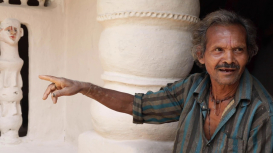The soil of Sarguja is rich, loamy and varied. Deep black, ochre and white, their colour and texture lends itself to possibilities of being moulded by hand. The Rajwars, traditionally landowning farmer communities, have long held a special affinity with this clay, beyond the needs of occupation or even ritual. After their homes were built by men, Rajwar women plastered the walls of their homes with clay (lepai) embellishing them afresh every year after the rains. This process has nurtured their creativity, for clay embellishment has a special role in their lives and homes. After this form received recognition through the work of Sona bai Rajwar and others, it was seen to have a market potential, mostly as a craft that could help people from this region earn livelihoods. Training centers were set up, resulting in a spillage of its practice. Large- scale commissions for murals mostly in urban environments became its chief marketability. In this, aesthetic sensibilities were transformed, and the popular and kitsch entered its vocabulary.
This content has been created as part of a project commissioned by the Directorate of Culture and archaeology, Government of Chhattisgarh to document the cultural and natural heritage of the state of Chhattisgarh.



